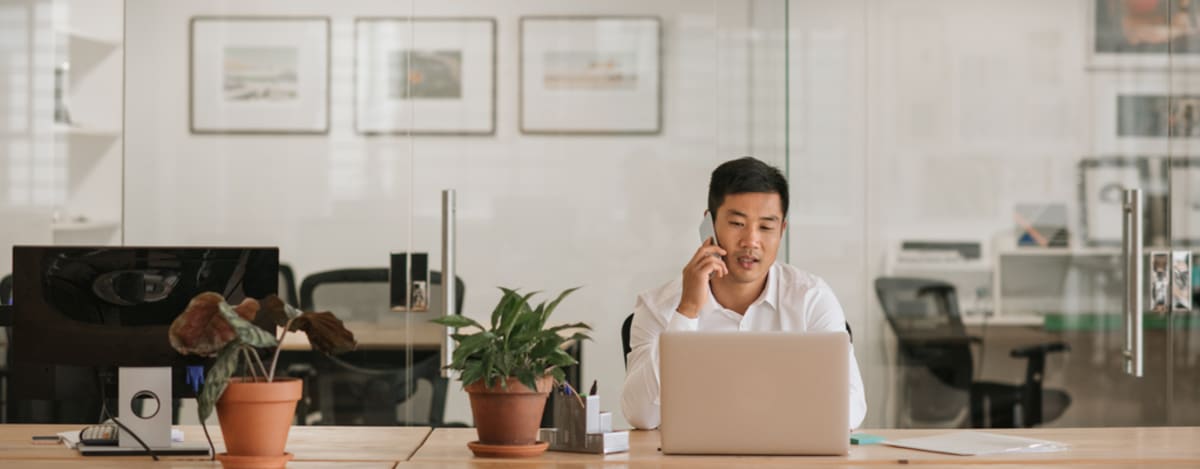With people returning to work, the design of the conventional office is suddenly in the spotlight. With health and hygiene concerns in mind, how much will workplaces need to change?
You arrive at your office, push open the door, and call the lift with a touch of a button. You take a snack from the communal kitchen, switch on your computer and pick up your desk phone. Later, you shake hands with a client, reach over your desk to borrow a colleague’s pen, and walk down the corridor alongside your boss.
Or do you? In a post-pandemic world, how many employees will think twice before undertaking any of these previously harmless activities when they return to work? With a degree of social distancing likely to be in effect for some time, and the psychological impact lingering long after that, many businesses will need to examine the gap between workers’ new health and hygiene expectations and the design of the modern office. How will the physical workplace need to change in the wake of COVID-19?
The ‘six feet office’
In April 2020, Fast Company reported on the ‘six feet office’, a new concept created by real estate company Cushman & Wakefield inside its Amsterdam headquarters. Jeroen Lokerse, head of Cushman & Wakefield in the Netherlands described it as both a “working laboratory and a showroom” for the firm’s clients, meant to call attention to how people might safely go back to work in offices.
The company, which helped 10,000 organisations in China move nearly one million people back to work in April, used its learnings from the experience, along with World Health Organisation data and the advice of medical specialists to inform the project. The six feet office includes design tools to keep employees six feet apart from each other, including barriers between desks, pedestrian lanes that keep traffic flowing in an orderly way, and disposable supplies to keep germs from spreading.
“The one thing we know for sure is that ‘back to normal’ in the workplace is going to be anything but normal,” Cushman & Wakefield CEO Brett White told CNBC. “The protocols that we’re going to need to implement in offices and industrial [and] retail buildings in which we operate are completely changing.”
A differently designed future
“How we think about the workplace will be the biggest change [to the design of the post-COVID-19 landscape],” agrees Darren Comber, chief executive of architecture practice Scott Brownrigg, speaking to The Guardian. “I’m not suggesting we all go back to working in 1950s cellular cubicles, but I do think the density in offices will change. We’ll see a move away from open-plan layouts, as well as better ventilation and more openable windows.”
“I think we’ll see wider corridors and doorways, more partitions between departments, and a lot more staircases,” adds Arjun Kaicker, head of analytics and insights at Zaha Hadid Architects, also speaking to The Guardian. “Everything [up until now] has been about breaking down barriers between teams, but I don’t think spaces will flow into each other so much anymore. Office desks have shrunk over the years, from 1.8m to 1.6m to now 1.4m and less, but I think we’ll see a reversal of that, as people won’t want to sit so close together.”
He imagines legislation might be introduced to mandate a minimum area per person in offices, as well as a reduction in maximum occupancy for lifts and larger lobbies to minimise overcrowding. His team is already working on a project that imagines “contactless pathways”, meaning employees will rarely have to touch a surface with their hands to navigate through the building. “Lifts can be called from a smartphone, avoiding the need to press a button both outside and in, while office doors will open automatically using motion sensors and facial recognition,” he explains.
Flexspace as office space
While all this sounds ideal, it’s perhaps not helpful for businesses looking for immediate solutions.
Research by Colliers International suggests that the concept of a ‘socially distanced office’ would render six out of ten workplaces temporarily unusable, due to a lack of space.
But does your business need office space all the time? One of the consequences of COVID-19 has been the rise in the touchless economy (also known as the “distance economy”), which comprises the economic activities that remain possible without close physical interaction between people. Online meetings and virtual conferences are two examples that look set to remain in some regard, even when the barriers to physical interaction are lifted.
Of course, there are still times when an office is required – for certain types of work, for sectors unable to do everything remotely, or for businesses who understand the value in social interaction between their workers. In this case, the solution could be the use of flexspace – flexible office space that can be scaled up or down in size as demand dictates, and which offers routine maintenance as part of the deal.
Flexspace grants a business access to a range of different types of office space that can be leased on a short-term basis. And while the demand for co-working spaces may be down for the meantime, the need for private offices is likely to go up. Large, airy meeting spaces could grow in popularity, while private pods may be appealing for workers. The clear benefit of being flexible, is that businesses can pick and choose which of these solutions works best for them in the short term – and then adapt as their needs change.
Before COVID-19, commercial real estate firm JLL stated that the flexspace sector could account for 30% of the office markets in the US by 2030. With businesses unable or unwilling to wait for the office design utopia promised by the architects, it’s likely that target could be reached much sooner.
Distributed workforces will be the new normal as businesses reduce risk and benefit from remote working. Flex and distribute your workforce using IWG’s portfolio of workspace solutions






